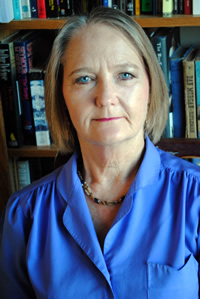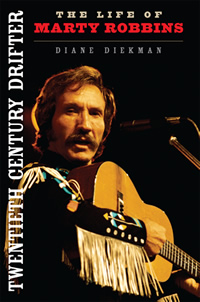When he was a young singer, they called him “the boy with the teardrop in his voice.” Two decades later, as the Grand Ole Opry moved from the Ryman to its new home at Opryland, Marty Robbins was the last artist on the old stage and the first to perform on the new. In her latest biography, Twentieth Century Drifter: The Life of Marty Robbins, Diane Diekman provides a remarkably detailed narrative account of one of country music’s most beloved figures.
A complex and private figure, Marty Robbins left an indelible footprint on the world of country music. During his three decades in entertainment, Robbins had ninety-four songs on the Billboard charts. Sixteen of those reached number one, and it’s impossible to visit El Paso, Texas, without hearing at least one of them. But Robbins wasn’t content with being only a singer-songwriter. He was also an actor, producer, mogul, and even a NASCAR driver. In Diekman’s account of his life, we hear from dozens of friends, musicians, employees, and relatives. More importantly, we hear from Marty Robbins himself. Diekman answered questions from Chapter 16 via email prior to her appearance on March 31 at the Country Music Hall of Fame and Museum in Nashville.
Chapter 16: A tireless entertainer, Robbins was a practical joker and notorious show-off, so I was surprised by your revelation of his severe shyness and lack of stage presence early in his career. How did he overcome this tendency to become the showman?
 Diekman: I’ve wondered about that, and it’s the first question I would have asked him. I think willpower and ambition gave him the determination to succeed. He told one interviewer, “I was really shy. I didn’t know how to talk to people. I couldn’t get up in front of them, but I knew that’s what I had to do. Gradually, I’ve learned how to perform and how to meet people.” He said when he moved to Nashville he “met stars, and I was just absolutely tongue-tied. I couldn’t say anything on the stage. It took me about three or four years to get over that.”
Diekman: I’ve wondered about that, and it’s the first question I would have asked him. I think willpower and ambition gave him the determination to succeed. He told one interviewer, “I was really shy. I didn’t know how to talk to people. I couldn’t get up in front of them, but I knew that’s what I had to do. Gradually, I’ve learned how to perform and how to meet people.” He said when he moved to Nashville he “met stars, and I was just absolutely tongue-tied. I couldn’t say anything on the stage. It took me about three or four years to get over that.”
Chapter 16: Because so much of the material in your book comes directly from Robbins’s former employees and band members, readers get a glimpse into the early days and evolution of the music industry in Nashville. Was the industry of that era, at least as far as Robbins’s work is concerned, more organic, less calculated, than it is now?
Diekman: It was more social then, that’s for sure, with emphasis on skill rather than electronic technology. Musicians and singers no longer come together in a recording studio to cut a song. Much of the sound is artificial. I think Marty would have been frustrated by today’s electronic manipulation but would have appreciated higher sound quality.
Chapter 16: Early in his career, Robbins preferred to work with music-business offices in New York or Los Angeles. Why was that?
Diekman: It wasn’t necessarily preference. Marty went wherever the recording situation worked best. He was called to Hollywood for his first session. Dallas and Nashville sessions followed. He recorded his biggest hit, “Singing the Blues,” in Nashville and followed that by recording “A White Sport Coat (and a Pink Carnation)” and his other teen ballads at the Columbia studio in New York City. Those producers wouldn’t accept his western songs, and he finally convinced Don Law in Nashville to record “El Paso.” Once he had enough clout, and whenever he didn’t agree with decisions being made in Nashville, he talked to record executives in Los Angeles and New York City.
 Chapter 16: Robbins is best known for 1959’s Gunfighter Ballads and Trail Songs, the album that included “El Paso.” The record was a huge commercial success that significantly influenced younger artists. Did Robbins have any inkling it would do as well as it did?
Chapter 16: Robbins is best known for 1959’s Gunfighter Ballads and Trail Songs, the album that included “El Paso.” The record was a huge commercial success that significantly influenced younger artists. Did Robbins have any inkling it would do as well as it did?
Diekman: No. He recorded the album because he’d written a number of western songs, and he liked old cowboy songs. He said in an interview, “I had no idea there would be a big market for it, but at that time we put out four albums a year. And it was just different than what I had been doing. So I asked Don Law if I could do an album of cowboy songs. He said, ‘Yeah, if you want to.’ He titled the album Gunfighter Ballads and Trail Songs, because I had no idea what to call it.”
Chapter 16: As a songwriter, Robbins was remarkably prolific and versatile, equally comfortable with teen pop or cowboy ballads. To what degree did he tailor his artistic direction to his fans’ preferences?
Diekman: He felt a connection between what he liked and what his fans wanted. In 1981, he said, “I have to do what I want to sing, because I owe it mostly to the people who have bought my records all these years. I’d say seventy percent of the singles I’ve recorded have been my own songs.” He added, “When I cut an album I can satisfy the people who put me where I am. And that is my main goal. I’m not cutting the kind of stuff that is selling today, because that’s not Marty Robbins.” He said he wanted his records to be “in the home” and that people would still be playing them “when I’m gone, fifty years from now.”
Chapter 16: Any idea why Robbins encouraged his son’s career as an artist but not his daughter’s?
Diekman: Marty would have accepted Janet in the business end of the industry but not on the performing side. He thought women weren’t treated well and he considered it “not a place for women.” Janet told me she thought he wanted “to see women treated well—but what a man thinks of as a woman being treated well, women who are coming into their own can think of as stifling.” He once told her, “Do anything you want to do in your life, but don’t go in the music business.”
Diane Diekman will discuss Twentieth Century Drifter: The Life of Marty Robbins at 12:30 p.m. on March 31 at the Country Music Hall of Fame and Museum in Nashville. Click herefor details.
Tagged: Nonfiction





